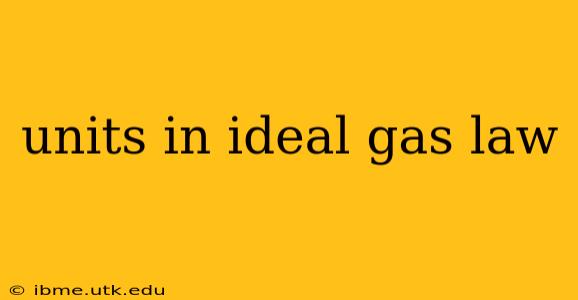The Ideal Gas Law, PV = nRT, is a fundamental equation in chemistry and physics, describing the behavior of ideal gases. Understanding the units involved is crucial for accurate calculations and a deeper comprehension of the law itself. This guide will delve into the units of each variable, explore common unit systems, and address frequently asked questions.
What are the units of each variable in the Ideal Gas Law?
Let's break down the units for each component of PV = nRT:
-
P (Pressure): Pressure is typically measured in atmospheres (atm), Pascals (Pa), millimeters of mercury (mmHg), or torr. 1 atm = 101325 Pa = 760 mmHg = 760 torr. The choice of unit depends on the context and the given data.
-
V (Volume): Volume is usually expressed in liters (L) or cubic meters (m³). 1 m³ = 1000 L. Again, consistency is key; use the same unit throughout your calculation.
-
n (Amount of substance): This represents the number of moles (mol) of gas present. A mole is a fundamental unit in chemistry, representing Avogadro's number (approximately 6.022 x 10²³) of particles.
-
R (Ideal gas constant): The ideal gas constant is a proportionality constant that relates the units of the other variables. Its value depends on the units used for pressure and volume. Here are some common values:
- 0.0821 L·atm/(mol·K) (When using atmospheres for pressure and liters for volume)
- 8.314 J/(mol·K) (When using SI units: Pascals for pressure, cubic meters for volume, and Joules for energy)
- 62.36 L·mmHg/(mol·K) (When using millimeters of mercury for pressure and liters for volume)
-
T (Temperature): Temperature must always be expressed in Kelvin (K). Kelvin is an absolute temperature scale, meaning it starts at absolute zero (0 K), where all molecular motion ceases. To convert from Celsius (°C) to Kelvin, use the formula: K = °C + 273.15.
What is the ideal gas constant? Why are there different values?
The ideal gas constant, R, is a fundamental constant that accounts for the proportionality between pressure, volume, amount of substance, and temperature. The different values of R reflect the different unit systems used for pressure and volume. Choosing the correct R value is essential to obtain the correct result. Using an incorrect R value will lead to an incorrect answer, regardless of the accuracy of your other measurements.
What units should I use for the Ideal Gas Law?
The best unit system to use depends on the context of the problem. For many chemistry problems, using L, atm, mol, and K (with R = 0.0821 L·atm/(mol·K)) is convenient and common. However, in physics, using SI units (m³, Pa, mol, K, with R = 8.314 J/(mol·K)) is often preferred for consistency. The key is to maintain consistency throughout your calculation; using a mixture of units will lead to errors.
Can I use different units for pressure and volume in the Ideal Gas Law?
No, you cannot arbitrarily mix and match units for pressure and volume. The ideal gas constant, R, is specific to a particular set of units. If you use a value of R that corresponds to atmospheres and liters, you must use atmospheres for pressure and liters for volume. Mixing units will lead to incorrect results.
How do I convert between different units in the Ideal Gas Law?
Conversion between units is often necessary. Familiarize yourself with the conversion factors between different pressure units (atm, Pa, mmHg, torr) and volume units (L, m³). Always ensure your units are consistent with the R value used.
By understanding the units of each variable and carefully selecting the appropriate value of R, you can accurately apply the Ideal Gas Law to a wide range of problems in chemistry and physics. Remember, consistency is key to avoiding errors.
